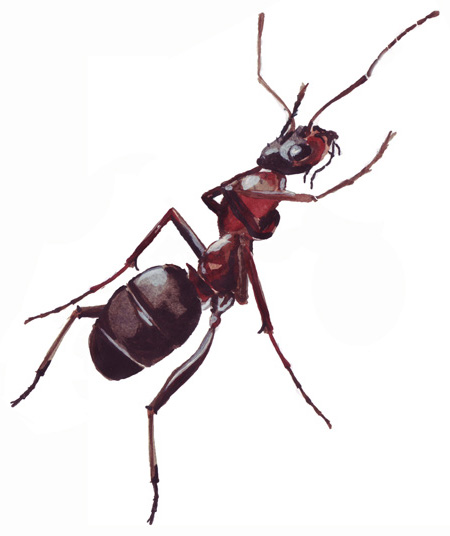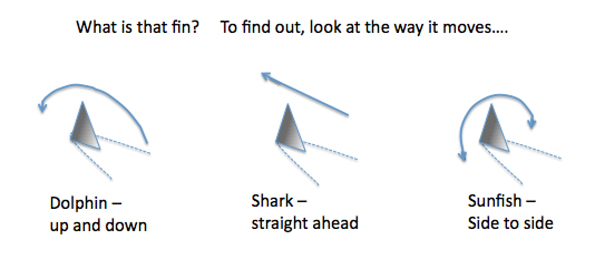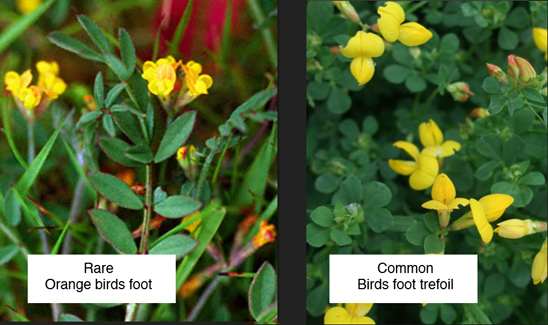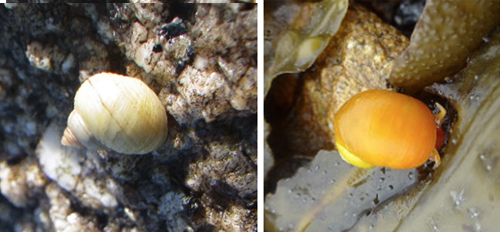

Some animals and plants to look out for and notes on where they might be when you cant see them!
For some of Scilly’s wildlife, the sea is a barrier that prevents them from breeding with populations on the mainland. For those species, genetic differences that appear in the islands are more likely to persist within the island population. These differences build up with time and gradually after many generations of breeding in isolation they give rise to new and unique local species.
St Martins Ant Formica rufibarbis.
These red-and-black coloured ‘Red Barbed Ants’ are unique to Scilly. They live in colonies undergound on Chapel Down, St Martins. DNA sequencing shows that they are very different to other European F. rufibarbis ants and have probably been in Scilly since the last Ice Age. More >>
Scilly Shrew Crocidura suaveolens
These are thought to be a subspecies of Lesser White-toothed Shrew that is found exclusively in Scilly. It is not known whether they date back to the last Ice Age or arrived more recently. One possibility is that they derive from a small founding population introduced by man after Scilly became cut off from mainland Britain and Europe - Read more about the Scilly Shrew. - a puzzle with a piece missing.
In spite of their small size, the islands provide a range of different habitats that are home to a wide variety of plants and animals, for many of these, the islands provide a sanctuary free from large predators, pollution and frosts.
Lichens are a mutually beneficial coalition of fungi and algae in which specific fungi provide the structure, support, protection, water and minerals in exchange for sugars made by the particular photosynthetic algae inside them. Lichens thrive in Scilly’s mild climate and clean air, 16 of the 665 species here are nationally rare. Many species, including the aptly named ‘Golden Hair Lichen’ Teloschistes flavicans, can be seen on rocks and in heath and grassland. Identifying lichens >>
Song thrush Turdus turdus
These birds are becoming increasingly scarce in mainland Britain, but thrive in Scilly. Thrushes are often seen on or by grassy paths where they crack open banded snails using rock anvils which can be identified by the fragments of snail shell nearby. Their song contains characteristic repetitive elements. To hear a song thrush sing Go to >>
European eel Anguilla anguilla
This endangered species can sometimes be seen in the streams by the lower moors nature trail. The adult eels migrate across the Atlantic to spawn in the Sargasso sea. The young then return, helped by the North Atlantic Drift Current. More >>
Some species common in continental Europe are rarities or absent from mainland Britain, but are able to thrive in the warmer climate that Scilly enjoys.
Orange birdsfoot Ornithopus pinnatus
Scilly is the only place in Britain where you can find this plant. Its tiny deep yellow flowers, delicate leaflets and segmented seed pods help distinguish it from the abundant ‘Birdsfoot trefoil’ Lotus corniculatus. [Six spot burnet moth caterpillars feed on Birds foot trefoil and their yellow, spindle-shaped coccoons are often seen attached to long grass stems nearby.] The Orange birdsfoot grows in short turf and can be found on Castle Down Tresco, Heathy Hill Bryher, and on St Agnes.
Giant goby Gobius cobitis
This is a nationally rare species at the northern end of its range. It can grow up to 25 cm long and lives in rock pools high up the shore. The eggs are laid in a large cluster attached to a rock where they are guarded and tended by the male until they hatch. More >>
Scilly’s marine animals often travel considerable distances to feed. The exact movements of some larger birds, fish and mammals can be tracked by attaching mini transmitters which signal their locations via satellite.
Manx Shearwater Puffiinus puffiinus
Tracking six female shearwaters over a two-day foraging trip illustrates the locations of the three main feeding grounds (figure to right). Each colour represents a different bird and the spot density shows how much time each bird spent in that location: the bird whose trip is shown as blue spots fed at the Irish Sea front, whilst the one shown as black spots fed along the Ushant front and the birds shown as white, pink and yellow spots fed off the Continental shelf (Guilford et al 2009).
Gannet Morus bassana
Gannets can be seen diving for fish around the islands. Tracking data show that during the breeding season, adult birds typically fish over a range of 50-150 km. Birds from different colonies tend to fish in different feeding grounds, thus avoiding competition. Birds that have fished successfully seem to lead other birds from their colony to the good fishing spots. Read more >>
Whales and dolphins
Various cetaceans feed around the islands. The three most abundant species around Scilly are Harbour porpoise, Common dolphin and Minke whale. To minimise the numbers dying as bycatch in fishing nets, the numbers and locations of eleven cetacean species feeding around Britain and Ireland have been monitored, using sightings and acoustic surveys- you can see the results for the common dolphin to the right, and more on the SCANS II survey web pages.
Cetacean strandings- occasionally cetaceans are found washed up on the shores. If you fiind one, please report it at ukstrandings.org For skeletons and badly decayed corpses, information on dentition can be crucial for identification. This skeleton (right) found near the Great Bay St Martins in 2015 was widely believed to be a pilot whale, although the lack of teeth indicates that it was a Risso's dolphin or a Beaked whale.
Some birds, fish and insects migrate north to Scilly to feed or breed.
Manx shearwater Puffinus puffinus
These seabirds spend their winters in South America. They arrive in Scilly in March to nest in burrows on Annet and St Agnes and leave Scilly in July. A recent conservation project has successfully eliminated brown rats from St Agnes to improve the breeding success of the shearwaters and other ground-nesting birds.
Basking shark Cetorhinus maximus
These are migratory, feeding in areas of high plankton density. In summer, they can be seen around the outer parts of the archipelago where tidal flow mixes the water and encourages plankton growth. In winter they feed further south, off the continental shelf. More >>
Sunfish Mola mola
These strangely shaped fish hold the record as the heaviest bony fish. They are occasionally seen basking near the surface. Their preferred food is jellyfish. Tagging experiments show that they migrate seasonally, returning south towards Spain in the autumn. More >>

Most marine invertebrates have planktonic larval stages to aid dispersal, avoid predation and exploit alternative ecological niches. (More on the ecological and evolutionary consequences of having planktonic larval stages). These microscopic larvae are poor swimmers, but hitch rides on different currents by moving up or down. More on larval migration patterns >>
Shore crab Carcinus maenas
Crabs have exoskeletons which they shed as they grow. Many of the crab shells you find on the shore are these cast-off exoskeletons. Female crabs carry their eggs under their body until they hatch. The microscopic larvae move up to the surface as the tide goes out and are carried out to sea. More >> After three weeks feeding at sea the planktonic larvae drift back in to the shore.
Acorn barnacles
Acorn barnacles look superficially like small limpets, but are in fact crustaceans. As adults, they are stuck fast to the rock and unable to move, so they have planktonic larvae which are essential for dispersal. Most barnacles in Scilly are species of Chthamalus. The local currents do not contain enough larvae of Semibalanus barnacle species, common elsewhere, for effective colonisation. Two species of Chthamalus barnacle that are abundant in Scilly have different habitat preferences - Chthamalus montagui prefers to live in the high- to mid-tide zone on less exposed shores whereas Chthamalus stellatus chooses the mid- to low-tide zone on more exposed shores. The last larval stage is adapted for choosing and cementing to the final settlement site. More about settlement choices: academic >> and popular >>
The seashore can be a difficult place to live. Rising and falling tides bring alternating risks of being washed away and of desiccation.
Two periwinkle species you can find in Scilly have different ways of ensuring their young survive.
Littorina saxatilis lives high up the shoreline and protects its developing eggs in brood pouches inside its shell. Littorina obtusata lives lower down the shoreline where there is less risk of dessication, it sticks clumps of eggs to seaweed. In both these species, the eggs hatch into shelled young, thereby avoiding a planktonic phase. A third species, Littorina littorea, rarely if ever found in Scilly, broadcasts eggs and sperm which give rise to planktonic larvae.
Cuckoo
In Scilly, cuckoos often choose rock pipits' nests to lay their eggs in and in late July/August you may see these small thrush-like birds feeding a voracious parasitic cuckoo fledgling on coastal paths near the rocky crevices where the rock pipits nest (how cuckoos choose their hosts). Cuckoos mimic the hosts' egg pattern when they lay, to reduce the chance that their eggs will be noticed and rejected.
Black oil beetle Meloe proscarabaeus
These beetles grow up to 3 cm long and can be seen on foot paths, burrowing into bare ground to lay their eggs. Black oil beetles parasitise solitary mining bees. On hatching, the young oil beetles crawl up into a flower to climb onto a visiting bee and then feed on the bee’s eggs and its store of honey and pollen.
St Martins Ant Visit Ant page >>
Scilly Shrew
Golden hair lichen More >>
Song thrush cracking a snail
European eel life cycle

Orange birds foot (left)
and Birds foot trefoil (right)
Giant goby
Shearwater journeys show main feeding grounds.
Common dolphin sightings 2006 from SCANS II survey
Cetacean skeleton - Risso's dolphin or Beaked whale

Manx shearwaters
Shore crab larvae
Acorn barnacle larvae

Littorina saxatilis (Left)
Littorina obtusata (Right)
Rock pipit feeding juvenile cuckoo
Black oil beetle
Copyright © 2016 Creative Commons